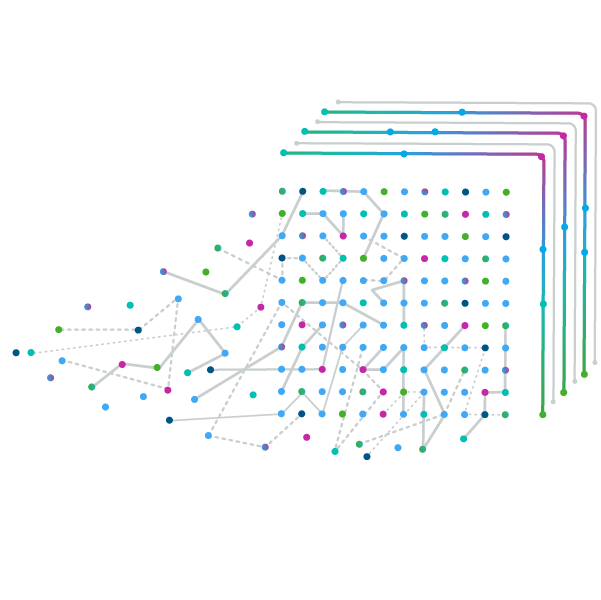Meet the challenge of changing stakeholder demands and increasing cost constraints with IQVIA's integrated technology services and analytics-driven offerings.
Artificial intelligence is at the heart of pharma’s digital transformation. When deployed correctly, AI algorithms reduce manual labor, speed access to insights, and provides quality teams with more robust information in less time to support more effective decision-making.
But it only works if the AI is proven reliable, and users trust the output.
“If you're using AI in a critical system it has to be reliable, and it has to be designed in a way that the worst-case scenario is not going to lead to failure,” said Matt O'Donnell, Global Lead, Life Sciences ISV Partners at Microsoft.
O'Donnell recently participated in the IQVIA webinar: Futureproofing Your Quality Operations Through Digital Transformation, where he and Mike King, Senior Director, Product & Strategy at IQVIA discussed the evolution of AI in pharma, and how it is driving innovation in the quality environment.
Just the beginning
For most pharma leaders, this transformation has only just begun. While the majority of webinar attendees believe that AI in quality operations will improve process time and consistency of performance (54%), 72% admitted that they aren’t yet using AI in their quality operations.
That set the tone for the conversation, where O’Donnell and King discussed how AI is being used in pharma today, where it can add value, and how companies can access all of the benefits of AI in a safe and compliant way.
Below are some of the insights we captured from their conversation.
How does AI add value to quality processes?
O’Donnell: AI simulates human decision-making and imitates human intelligence to deliver stronger, more accurate, and more repeatable solutions. It can copy all of the cognitive senses, and combine deep knowledge and search capabilities to identify connections that might not have been known before.
King: AI can also help capture insights from structured data in a more timely manner. For example, many companies have a record of submission pathways for audits of nonconformances, or of CAPA (Corrective and Preventive Actions) closures, which results in a huge volume of data. Using AI, they can mine precedents in that data to understand what decisions were taken historically, what potential pathways lead to certain outcomes, and where additional pathways or alternatives could bring faster, safer decision making. That's where AI can really provide insights across the quality management systems that we operate in.
How is copying human senses useful to quality processes?
O’Donnell: Consider ‘vision’. So much information in healthcare is captured in a semi-structured way. It might be in a PDF, or a patient scan, or a handwritten record. That's valuable information but to unlock it, you first need to use Optical Character Recognition to scan it and turn it into a structured document so the system can process the data.
King: The key is combining the technology with the knowledge of our teams to make better decisions that are more predictable and more consistent. There are great opportunities to use targeted algorithms to identify patterns and trends that may not be seen by the human eye.
What is “connected intelligence” and what role does it play in this transformation?
King: Connected intelligence is the bringing together of systems driven by intelligence, with the support of AI to rapidly focus on those insights that we may not yet understand. AI enables connected intelligence so that we can capture relevant insights in a timely manner to drive the right actions.
O’Donnell: That speed is essential, especially for quality surveillance of a drug or medical device in the market. Monitoring for early indications of adverse events requires reviewing thousands of documents to find connections that make sense. AI can find those connections, making it easy for quality teams to gain knowledge from semi structured and unstructured data.
In such a highly regulated environment, can we really rely on AI to answer questions and provide insights? What if it gets it wrong?
O’Donnell: We are often asked whether AI is appropriate for healthcare, and whether it is sufficient. I always point to the progress we’ve made. Over the last six years, AI systems have reached near human parity for general purpose. And while the medical domain is more challenging, the next wave of transformation in this space is already happening, bringing AI at scale.
We already see great accuracy with natural language processing, which when it's trained on medical publications can deliver 90+ percent accuracy. And when an algorithm is trained for a highly specific medical task, like identifying and tracking brain tumors, it can be extremely accurate.
We continue to make improvements, by using the trillions of healthcare documents we have access to train algorithms and create better simulations of human intelligence.
King: It’s also important that stakeholders be able to trust the technology. For an organization to adopt AI, it must quantify the benefits in terms of consistency, resource utilization, and in identifying things that the human eye and the human brain cannot find on its own. Only when organizations quantify that benefit and present it to their various stakeholders is there an opportunity for true adoption.
How can companies convince stakeholders to embrace AI?
King: Many companies take a staged approach. Some start with the safety field, using AI to manage adverse event reports and to process product complaints; where others may start by embedding AI in a quality management system to support audits, inspections, and document drafting. It depends on where the opportunity lies for the organization, where their strengths lie, and where those discussions land with senior stakeholders.
What are you most excited about as you watch the transformation of AI in life sciences?
O’Donnell: There is a shift going on right now. It's not just about one company producing great AI models. I see collaborations between academia, different companies, and different technology providers. They are coming together to produce the best AI models that can advance benefits for the entire human population.
King: There are so many applications for AI, and so many opportunities to use sophisticated algorithms to help organizations enhance the focus on patient safety by being able to detect signals that we may not otherwise see. Once companies weigh the benefits, the potential risks and the costs they will see the incredible value of AI and how it can enhance activities across the operation.
To hear more of their conversation, click here to listen to the entire webinar, or contact Regulatory_Quality_Compliance@iqvia.com to learn more.
Related solutions
From manufacturing oversight to regulatory requirements, manage quality across your organization with a single enterprise software solution.
Outdated compliance practices aren't viable amid evolving market and regulatory changes. IQVIA’s award-winning, end-to-end quality management system streamlines the product value chain, accelerates market entry, safeguards companies and patient safety, and meets complex regulatory demands.

























